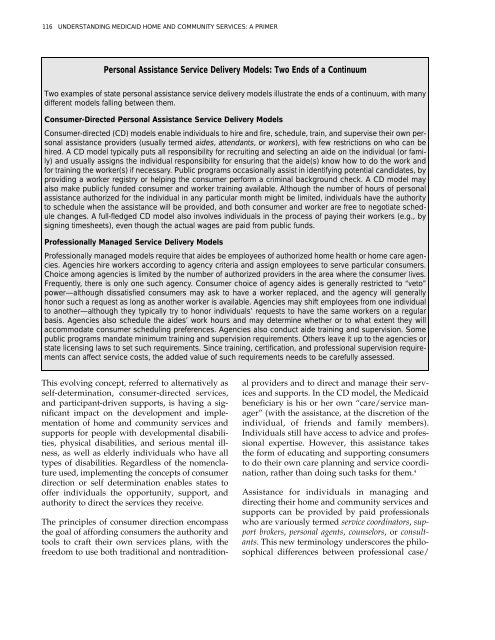Full PDF Version - ASPE - U.S. Department of Health and Human ...
Full PDF Version - ASPE - U.S. Department of Health and Human ...
Full PDF Version - ASPE - U.S. Department of Health and Human ...
- No tags were found...
Create successful ePaper yourself
Turn your PDF publications into a flip-book with our unique Google optimized e-Paper software.
116 UNDERSTANDING MEDICAID HOME AND COMMUNITY SERVICES: A PRIMERPersonal Assistance Service Delivery Models: Two Ends <strong>of</strong> a ContinuumTwo examples <strong>of</strong> state personal assistance service delivery models illustrate the ends <strong>of</strong> a continuum, with manydifferent models falling between them.Consumer-Directed Personal Assistance Service Delivery ModelsConsumer-directed (CD) models enable individuals to hire <strong>and</strong> fire, schedule, train, <strong>and</strong> supervise their own personalassistance providers (usually termed aides, attendants, or workers), with few restrictions on who can behired. A CD model typically puts all responsibility for recruiting <strong>and</strong> selecting an aide on the individual (or family)<strong>and</strong> usually assigns the individual responsibility for ensuring that the aide(s) know how to do the work <strong>and</strong>for training the worker(s) if necessary. Public programs occasionally assist in identifying potential c<strong>and</strong>idates, byproviding a worker registry or helping the consumer perform a criminal background check. A CD model mayalso make publicly funded consumer <strong>and</strong> worker training available. Although the number <strong>of</strong> hours <strong>of</strong> personalassistance authorized for the individual in any particular month might be limited, individuals have the authorityto schedule when the assistance will be provided, <strong>and</strong> both consumer <strong>and</strong> worker are free to negotiate schedulechanges. A full-fledged CD model also involves individuals in the process <strong>of</strong> paying their workers (e.g., bysigning timesheets), even though the actual wages are paid from public funds.Pr<strong>of</strong>essionally Managed Service Delivery ModelsPr<strong>of</strong>essionally managed models require that aides be employees <strong>of</strong> authorized home health or home care agencies.Agencies hire workers according to agency criteria <strong>and</strong> assign employees to serve particular consumers.Choice among agencies is limited by the number <strong>of</strong> authorized providers in the area where the consumer lives.Frequently, there is only one such agency. Consumer choice <strong>of</strong> agency aides is generally restricted to “veto”power—although dissatisfied consumers may ask to have a worker replaced, <strong>and</strong> the agency will generallyhonor such a request as long as another worker is available. Agencies may shift employees from one individualto another—although they typically try to honor individuals’ requests to have the same workers on a regularbasis. Agencies also schedule the aides’ work hours <strong>and</strong> may determine whether or to what extent they willaccommodate consumer scheduling preferences. Agencies also conduct aide training <strong>and</strong> supervision. Somepublic programs m<strong>and</strong>ate minimum training <strong>and</strong> supervision requirements. Others leave it up to the agencies orstate licensing laws to set such requirements. Since training, certification, <strong>and</strong> pr<strong>of</strong>essional supervision requirementscan affect service costs, the added value <strong>of</strong> such requirements needs to be carefully assessed.This evolving concept, referred to alternatively asself-determination, consumer-directed services,<strong>and</strong> participant-driven supports, is having a significantimpact on the development <strong>and</strong> implementation<strong>of</strong> home <strong>and</strong> community services <strong>and</strong>supports for people with developmental disabilities,physical disabilities, <strong>and</strong> serious mental illness,as well as elderly individuals who have alltypes <strong>of</strong> disabilities. Regardless <strong>of</strong> the nomenclatureused, implementing the concepts <strong>of</strong> consumerdirection or self determination enables states to<strong>of</strong>fer individuals the opportunity, support, <strong>and</strong>authority to direct the services they receive.The principles <strong>of</strong> consumer direction encompassthe goal <strong>of</strong> affording consumers the authority <strong>and</strong>tools to craft their own services plans, with thefreedom to use both traditional <strong>and</strong> nontraditionalproviders <strong>and</strong> to direct <strong>and</strong> manage their services<strong>and</strong> supports. In the CD model, the Medicaidbeneficiary is his or her own “care/service manager”(with the assistance, at the discretion <strong>of</strong> theindividual, <strong>of</strong> friends <strong>and</strong> family members).Individuals still have access to advice <strong>and</strong> pr<strong>of</strong>essionalexpertise. However, this assistance takesthe form <strong>of</strong> educating <strong>and</strong> supporting consumersto do their own care planning <strong>and</strong> service coordination,rather than doing such tasks for them. 4Assistance for individuals in managing <strong>and</strong>directing their home <strong>and</strong> community services <strong>and</strong>supports can be provided by paid pr<strong>of</strong>essionalswho are variously termed service coordinators, supportbrokers, personal agents, counselors, or consultants.This new terminology underscores the philosophicaldifferences between pr<strong>of</strong>essional case/
















